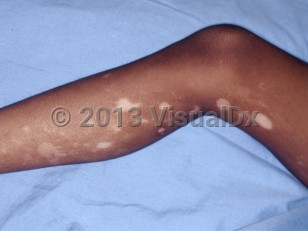Segmental vitiligo in Infant/Neonate
Alerts and Notices
Important News & Links
Synopsis

Segmental vitiligo is considered a subtype of vitiligo but is usually thought of as a separate entity than generalized vitiligo. It is marked by early onset progressive development of circumscribed depigmented macules or patches in a segmental pattern over a period of 6-24 months, followed by rapid spontaneous stabilization. It can be distinguished from generalized vitiligo by its unique unilateral distribution (lesions do not cross the midline) and rapid stabilization. The underlying mechanism is still controversial, although, similar to generalized vitiligo, it is thought to be due to an autoimmune response to melanocytes. It has been suggested that segmental vitiligo is due to a somatic mosaicism in the setting of an early postzygotic event that predisposes only a group of related melanocytes to the autoimmune response.
Segmental vitiligo is 10 times less common than generalized vitiligo. It typically has an earlier age of onset compared with generalized vitiligo. The majority of cases occur before age 30, from infancy to adulthood. The lesions are usually chalk-white in color with well-demarcated margins. They range in size from millimeters to centimeters. The affected skin is asymptomatic but is more prone to sunburn. There is a higher frequency of leukotrichia (white hair) compared to nonsegmental vitiligo. Segmental vitiligo typically involves a single segment (monosegmental) on only one side of the body. However, rare variants that involve multiple segments (distributed either unilaterally or bilaterally) have been reported. Segmental vitiligo typically evolves over a few months after initial presentation and then remains stable in appearance.
Concomitant occurrence of segmental and generalized vitiligo has been described and is referred to as mixed vitiligo. In such cases, segmental disease usually precedes the generalized form by at least 6 months.
Segmental vitiligo is 10 times less common than generalized vitiligo. It typically has an earlier age of onset compared with generalized vitiligo. The majority of cases occur before age 30, from infancy to adulthood. The lesions are usually chalk-white in color with well-demarcated margins. They range in size from millimeters to centimeters. The affected skin is asymptomatic but is more prone to sunburn. There is a higher frequency of leukotrichia (white hair) compared to nonsegmental vitiligo. Segmental vitiligo typically involves a single segment (monosegmental) on only one side of the body. However, rare variants that involve multiple segments (distributed either unilaterally or bilaterally) have been reported. Segmental vitiligo typically evolves over a few months after initial presentation and then remains stable in appearance.
Concomitant occurrence of segmental and generalized vitiligo has been described and is referred to as mixed vitiligo. In such cases, segmental disease usually precedes the generalized form by at least 6 months.
Codes
ICD10CM:
L80 – Vitiligo
SNOMEDCT:
403268000 – Segmental vitiligo
L80 – Vitiligo
SNOMEDCT:
403268000 – Segmental vitiligo
Look For
Subscription Required
Diagnostic Pearls
Subscription Required
Differential Diagnosis & Pitfalls

To perform a comparison, select diagnoses from the classic differential
Subscription Required
Best Tests
Subscription Required
Management Pearls
Subscription Required
Therapy
Subscription Required
References
Subscription Required
Last Reviewed:01/31/2017
Last Updated:01/08/2024
Last Updated:01/08/2024

